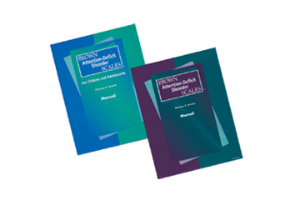Author:
Thomas E. Brown
Overview:
Quickly screen for reliable indications of ADD
Age Range:
3 through adult
RTI Tiers:
RTI Levels 2 and 3
Completion Time:
10 to 20 minutes
Forms:
Four: Primary/Preschool (ages 3-7); School-age (ages 8-12); Adolescent (ages 12-18); Adult (18+)
Norms:
Clinically validated Cut Score
Publication Date:
2001, 1996
Obtain a consistent measure of ADD across the life span with the Brown Attention-Deficit Disorder Scales® for Children and Adolescents and the Brown Attention-Deficit Disorder Scales for Adolescents and Adults. Based on Thomas Brown’s cutting-edge model of cognitive impairment in ADD, the Brown ADD Scales explore the executive cognitive functioning aspects of cognition associated with AD/HD (ADD).
Extended Age Range
With the new Brown ADD Scales for Children that include a primary/preschool scale (ages 3–7) and a school-age scale (ages 8–12), in addition to the adolescent and adult scales already available, the Brown ADD Scales allow you to comprehensively assess ADD in individuals of all ages.
Clusters of Executive Functions
The Brown ADD Scales go beyond measures that address only hyperactivity to assess for less apparent impairments of executive functioning. The manuals explain the new understanding of ADD as complex impairments of executive functions that impact academic, social, emotional and behavioral functioning.
As with the adolescent and adult version, the children’s edition features five clusters frequently associated with ADD—plus a sixth one, Monitoring and Self-Regulating Action, that encom-passes problems in appropriately controlling behavior:
- Organizing, Prioritizing and Activating to Work
- Focusing, Sustaining and Shifting Attention to Tasks
- Regulating Alertness, Sustaining Effort and Processing Speed
- Managing Frustration and Modulating Emotions
- Utilizing Working Memory and Accessing Recall
- Monitoring and Self-Regulating Action
User-Friendly
You can administer any of these 40 to 50-item efficient screening instruments in just 10 to 20 minutes. Easy to understand parent and teacher questionnaires are available for the children’s version, and self-report forms are provided for ages 8 through adults to obtain information that may be overlooked by observers.
Variety of Uses
Use the Brown ADD Scales for screening, as part of a comprehensive diagnosis, and for monitoring of treatment responses in a wide range of educational, clinical, and managed care settings.
Relationship with Intelligence and Memory
The manual for the adolescent and adult scales helps to integrate performance with the Wechsler Adult Intelligence Scale®—Third Edition (WAIS®–III), while the children’s manual relates performance to scores from the Wechsler Intelligence Scale for Children®—Third Edition (WISC–III®) and select subtests of the Children’s Memory Scale™. The manuals provide instructions for interpretation and linking performance on the Brown ADD Scaleswith IQ and other assessment data.
Comprehensive Diagnostic Form
The Brown ADD Diagnostic Form allows you to gather and integrate important diagnostic information about an individual, with cluster and total scores arriving at a diagnostic decision. The Diagnostic Form helps you conduct a comprehensive evaluation, with a set of procedures for integrating a clinical history, a comorbidity screener, and a worksheet for integrating data from the Brown ADD Scales with standardized scores from other tests.
Flexible Scoring
The convenient READY SCORE® form gives you immediate cluster scores and a total score indicating overall impairment from a broad range of ADD symptoms. T scores give you an indication of how much impairment the examinee is showing on each of the clusters, relative to a normative population. Results indicate whether the individual appears to have ADD and would benefit from a full evaluation for the disorder.
Simplify scoring and reporting with the efficient Brown ADD Scales Scoring Assistant® which allows you to quickly score and analyze results from all the Brown ADD Scales. The software accepts record form inputs; maintains multiple record forms for an examinee; exports record form data; and generates a graphical and narrative report. This timesaving program allows you to spend less time on scoring so you can focus on developing appropriate interventions and monitoring the effectiveness of treatments for your child, adolescent and adult clients.
Hardware Requirements
Windows® 95/98/2000/Me/NT 4.0
Workstation Operating System
100 MHz Pentium processor
(166 MHz recommended)
32 MB RAM (64 MB recommended)
2 MB video card capable of 800 x 600 resolution (256 colors)
20 MB free hard disk space
CD-ROM drive recommended
PsychCorp CENTER DESKTOP
The Brown ADD Scales Scoring Assistant is part of The Psychological Corporation Assessment Center Desktop System, a new software platform that allows for the integration of client demographic data and cross battery analysis across all new Scoring Assistant® and Writer™software.
Call for a free brochure, 999-8904-994-WP299.
Pre-recorded Webinars
-
An Overview of ADHD
Presenter: Peter C Entwistle, PhD, Chris Huzinec
In this introductory overview webinar we will review the new criteria for the diagnosis of Attention Deficit Hyperactivity Disorder (ADHD) in DSM-5 and changes from the earlier DSM. We will also discuss the prevalence of the disorder, the characteristics of ADHD, and the adverse impact of cognitive and executive deficits on learning and achievement. Severity and co-morbidity of symptoms will also be explored.
After this webinar you will know the answers to the following questions:
- Are there rule outs?
- What is the experience of a child or adolescent like with a diagnosis of ADHD?
- What obstacles and problems do they face as they go through school and college?
- What other problems are seen in children with ADHD?
- What do they need to help them succeed?
Date: Mar 22, 2018
 PDF: An Overview of ADHD
PDF: An Overview of ADHD
 Video: An Overview of ADHD
Video: An Overview of ADHD






